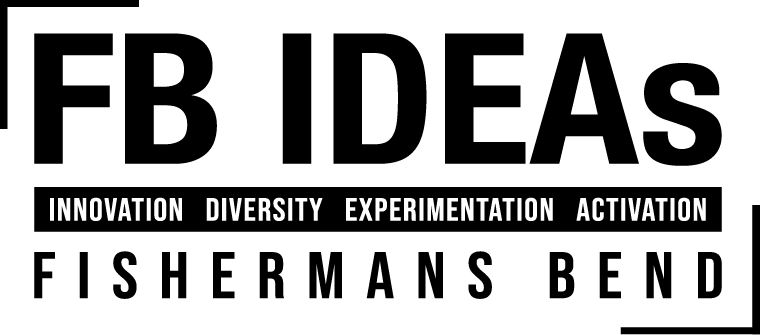Art + Engineering: Unlocking New Forms of Collaboration in Fishermans Bend
Panel speakers, from left to right: Yandell Walton, Maarten van Herk (South East Water), Melissa DeLaney (ANAT), Kate Spencer (FB IDEAs), Brandon Fisher (Siemens Mobility), Callan Morgan (Pelican Studios) and Damiru Dharmadasa (Siemens Mobility)
Last month, creativity and innovation met in a spirited conversation that explored what happens when artists and engineers collaborate to shape new ways of thinking.
Hosted at the FB IDEAs Hub, we were joined by the teams behind two remarkable projects that FB IDEAs was supported over the last 12 months. The Mira Solar Flower, led by artist Callan Morgan of Pelican Studios in partnership with Siemens Mobility, and Re:cultivate, an artist residency featuring Yandell Walton, developed by the Australian Network for Art & Technology (ANAT) with South East Water as the industry partner.
Both projects emerged from the belief that collaboration across disciplines can generate ideas far greater than the sum of their parts.
Fishermans Bend has always been a place of design, engineering, and making - so it’s the perfect testing ground to explore new models for cross-disciplinary collaboration. In discussion with the project teams, it was great to see how creative ecosystems evolve when artists and engineers learn from each other.
Mira Solar Flower
Image Credit: Images of the Mira Solar Flower in development and visualisations from the video on Vimeo
For Callan Morgan, the Mira Solar Flower represents a fusion of art, ecology, and technology—a 14-metre solar-powered sculpture designed to mirror the rhythms of the natural world. “Nature doesn’t waste energy,” he said. “It’s elegant and functional. That’s what we’re learning to emulate through engineering.”
Working alongside Brandon Fisher, Damiru Dharmadasa and the team from Siemens Mobility based in Fishermans Bend, the project team explored how digital simulation tools could transform creative vision into tangible design, bridging art’s organic intuition with the precision of structural analysis.
Re:cultivate
Images Credit: Images from Yandell Walton’s visual experiments using Unreal Engine with water data and 3D scanning technologies. Find out more by viewing Yandell’'s creative research journal on the ANAT website
Embracing a different model for collaboration, Yandell Walton’s Re:cultivate residency turned water itself into a collaborator. Unlike the Mira Solar Flower project where collaboration was built around an existing project vision, Yandell embarked on a journey of exploration and experimentation with no defined output in mind. Using real-time environmental data and 3D scanning technologies, she created immersive visualisations that reveal the agency of water in urban systems.
Working with inputs from Maarten van Herk and the team at South East Water, her work reframes water as a living participant in the city’s ecosystem rather than a resource to be controlled. For the team at South East Water, the process of collaboration offered a new way to approach their work. As Maarten van Herk reflected, “It gives us a new lens on something we often see only through numbers.”
Melissa DeLaney, CEO of ANAT who have brokered partnerships between artists and researchers for over 30 years, described these collaborations as “regenerative systems” — partnerships that don’t just sustain but actively renew ways of working.
Experimentation embracing courage and curiosity
Both projects underscore how creative inquiry and technical expertise can intertwine to imagine more responsive, resilient urban futures. But as the evening drew to a close, one theme resonated: experimentation takes courage and curiosity.
Brandon Fisher’s advice for his colleagues working in engineering was “go to events outside of engineering conventions, go out to art galleries or explore projects like FB IDEAs’ Circular Design Collective.”
In closing Damiru Dharmadasa, who has been with Siemens Mobility as an Engineering Intern throughout this project, also said: “Projects like this remind us that innovation doesn’t come from staying in your lane. It’s about learning from what doesn’t work, and letting passion and vision drive the process.”
Both projects highlight that new models for collaboration in places like Fishermans Bend can unlock benefits for both artists and engineers — collaborations where curiosity, respect for difference, and a shared sense of purpose fuel a community capable of imagining the city’s future together.







